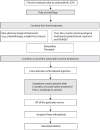9. Chronic knee pain
- PMID: 39219017
- PMCID: PMC11680467
- DOI: 10.1111/papr.13408
9. Chronic knee pain
Abstract
Introduction: Chronic knee pain is defined as pain that persists or recurs over 3 months. The most common is degenerative osteoarthritis (OA). This review represents a comprehensive description of the pathology, diagnosis, and treatment of OA of the knee.
Methods: The literature on the diagnosis and treatment of chronic knee pain was retrieved and summarized. A modified Delphi approach was used to formulate recommendations on interventional treatments.
Results: Patients with knee OA commonly present with insidious, chronic knee pain that gradually worsens. Pain caused by knee OA is predominantly nociceptive pain, with occasional nociplastic and infrequent neuropathic characteristics occurring in a diseased knee. A standard musculoskeletal and neurological examination is required for the diagnosis of knee OA. Although typical clinical OA findings are sufficient for diagnosis, medical imaging may be performed to improve specificity. The differential diagnosis should exclude other causes of knee pain including bone and joint disorders such as rheumatoid arthritis, spondylo- and other arthropathies, and infections. When conservative treatment fails, intra-articular injections of corticosteroids and radiofrequency (conventional and cooled) of the genicular nerves have been shown to be effective. Hyaluronic acid infiltrations are conditionally recommended. Platelet-rich plasma infiltrations, chemical ablation of genicular nerves, and neurostimulation have, at the moment, not enough evidence and can be considered in a study setting. The decision to perform joint-preserving and joint-replacement options should be made multidisciplinary.
Conclusions: When conservative measures fail to provide satisfactory pain relief, a multidisciplinary approach is recommended including psychological therapy, integrative treatments, and procedural options such as intra-articular injections, radiofrequency ablation, and surgery.
Keywords: chronic knee pain; corticosteroids; genicular nerves; hyaluronic acid; osteoarthritis; radiofrequency treatment; spinal cord stimulation.
© 2024 The Author(s). Pain Practice published by Wiley Periodicals LLC on behalf of World Institute of Pain.
Conflict of interest statement
The authors declare no conflicts of interest. Jan Van Zundert and Leonardo Kapural are Editorial Board members of Pain Practice and co‐author of this article. To minimize bias, he was excluded from all editorial decision‐making related to the acceptance of this article for publication.
Figures



References
-
- National Clinical Guideline Centre . National Institute for health and clinical excellence: guidance. Osteoarthritis: care and management in adults. London: National Clinical Guideline Centre; 2014.
-
- Macías‐Hernández SI, Zepeda‐Borbón ER, Lara‐Vázquez BI, Cuevas‐Quintero NM, Morones‐Alba JD, Cruz‐Medina E, et al. Prevalence of clinical and radiological osteoarthritis in knee, hip, and hand in an urban adult population of Mexico City. Reumatol Clin (Engl ed). 2020;16:156–160. 10.1016/j.reuma.2018.06.001 - DOI - PubMed
Publication types
MeSH terms
LinkOut - more resources
Full Text Sources
Medical

